The popularity of fixed-rate cryptocurrencies is growing and expanding beyond the niche market, attracting new users
“Everything is in its infancy, but we can already say that stablecoins are able to transform the sphere of payments, and we are already preparing solutions,” Visa CEO Al Kelly said at a shareholders meeting in late January. This week, Visa officially conducted a trial launch of payments in stablecoins in the SWIFT system, but cryptocurrencies pegged to the dollar are already de facto becoming its alternative.
“Even if it’s still very early, we continue to believe that central bank digital currencies and stablecoins have the potential to play an important role in the payments industry, and we have a number of initiatives under way,” the company said.
. @cuysheffield and @visa have fell into the rabbit hole of Account Abstraction!
This is huge! pic.twitter.com/CFniLLBq5C
— Starknet-Ecosystem.com ✨ (@StarkNetEco) February 5, 2023
“These failures have not resulted in any credit losses for us […] Please be aware that we put a high priority on upholding the credibility of our brand as a symbol of trust, as well as the integrity of Visa’s payment system and the whole payment system, in all we do.
The use of stablecoins continues to grow in 2023. The most popular “stable coins” are USDT issued by Tether, USDC is a joint project of Circle and Coinbase, and BUSD is the own stablecoin of the largest crypto exchange Binance, created in partnership with Paxos. These three coins account for over 90% of the stablecoin market, according to DeFiLlama. All are presumably backed by the equivalent value of US dollar-denominated assets held as reserves, although their structure and management differ.
USDT from Tether has been the leader among “stable” coins for several years now. According to CoinGecko, its market capitalization as of February 9 is $68.2 billion. According to this indicator, it ranks third among the largest cryptocurrencies, behind only Bitcoin and Ethereum. Since 2021, Tether has been publishing quarterly reserve reports, and daily snapshots of the balance on its wallets are available on the company’s website.
On Thursday, February 9, the company reported a profit of over $700 million for the fourth quarter of 2022, also confirming that its reserves in dollar terms more than cover the volume of issued stablecoins.
Today, Tether Holdings Limited made available the assurance opinion for the year-end of December 31, 2022 that BDO, a top-five global independent public accounting firm, prepared. The Consolidated Reserves Report (CRR), which details the assets owned by the Group as of December 31, 2022, is reaffirmed as accurate by the attestation. The CRR reveals that Tether concluded 2022 with no commercial paper, at least $67 billion in consolidated total assets, and excess reserves of at least $960 million, in addition to decreasing its secured loans as committed.
The majority of Tether’s investments are held in cash, cash equivalents, and other short-term deposits, ensuring that its reserves are still incredibly liquid. The most recent report highlights a $300 million reduction in secured loans, a $700 million net profit addition to Tether reserves in the most recent quarter of 2022, and the highest percentage of assets allocated to US Treasury Bills to date, with direct exposure of more than 58%. These developments show the company’s commitment to transparency.
Stablecoins are indeed the main driving force for the crypto market – this is almost the only direct way of capital inflow, Large investors enter the market through the issuance of new stablecoins. Apart from mining and hybrid ICOs, this is the main way to expand liquidity for the market.
“The main idea of stablecoins was to provide an opportunity to conduct a clear and predictable investment strategy in a decentralized cryptocurrency market. But against the background of the stagnation of the crypto market, a secondary function of stablecoins came forward – transport. For a certain group of users, it often becomes the only one, ”
Thanks to the peg to hard currencies, stablecoins have proven themselves well in transfers: the volumes of transactions using stablecoins as a transfer method between two individuals may exceed the volumes of transfers in any other cryptocurrency, the expert suggests.
Algorithms and credits
In addition to the top three players in the stablecoin market, there are so-called “algorithmic” stablecoins backed by crypto assets rather than fiat currencies. More than half of them work on the Ethereum blockchain. Due to the decentralized structure and the issuance of new coins, not controlled by a single organization, this category of stablecoins offers new lending opportunities in decentralized finance (DeFi) protocols.
The DeFi space remains within a niche market, often difficult for an outside observer. According to Stani Kuleshov, the founder of one of the largest DeFi projects Aave, it is the distribution of decentralized stablecoins that can play into the hands of the entire field, attracting new participants to it.
Kulechov and Cointelegraph managing editor Alex Cohen discussed a range of subjects in a fireside chat titled “DeFi: Resilience in the Face of Global Uncertainty,” including the risks associated with DeFi compared to traditional finance (TradFi), as well as how stablecoins may encourage more DeFi adoption.
Kulechov asserts that DeFi products’ risk quantification is more accurate than that of TradFi ones, which would encourage increased adoption of space technology. According to the founder of Aave, operating in DeFi would become less expensive than in TradFi as the dangers may be more readily identified.
On February 9th, Aave developers launched their own stablecoin GHO on the Ethereum blockchain testnet for the final stage of testing before its release to the market.
The Aave Companies have been working hard, and we can’t wait to show you some of what we’ve been up to. With the launch of the GHO Testnet, the main GHO codebase will be released, which is now complete. Additionally, Open Zeppelin, SigmaPrime, and ABDK conducted three more audits. This version also suggests including a FlashMinter Facilitator as a second facilitator at GHO launch. This update will conclude by highlighting some crucial next actions for the neighborhood.

Among the cryptoasset-backed stablecoins, MakerDAO’s DAI is the leader, judging by its $5 billion market cap and brand awareness in the crypto community. Since its inception in 2017, the MakerDAO project has been designed as a decentralized autonomous organization (DAO). Interestingly, about half of the DAI coins in circulation have traditional centralized stablecoins such as USDT as collateral.
Beyond the crypto world
If complex decentralized tools are not yet truly widespread, then the largest stablecoins are already taking root in the economy of the real world. Venezuelans are paying with stablecoins to buy groceries in conditions of skyrocketing inflation, and European traders are using them as a gateway to do business with Asian marketplaces.
“Many factors influence the spread of stablecoins outside the cryptocurrency community. Chief among them last year were economic restrictions that forced some Russians to look for alternative ways to withdraw capital from the country. Similar restrictions around the world contribute to the growing popularity of this tool for withdrawing capital bypassing restrictions,”
Another driver of growth in popularity among the “non-cryptocurrency” audience is a simple protection against high inflation in countries with troubled economies. For example, countries in Central Africa and South America use stablecoins as a way to protect their national currencies from inflation. Buying “electronic dollars” for people is sometimes easier and more profitable than looking for cash from a “changer” in the local market, the analyst explains.
Trends and Leaders
Referring to statistics on exchange directions in Bestchange, Zuborev also talks about the growing popularity of exchange pairs involving stablecoins. Basically, the growth of this segment is provided by the directions for buying and selling USDT. Against the backdrop of the recent jump in the dollar against the ruble, the demand for the sale of USDT for rubles through a bank transfer overtook even the purchase of bitcoin, which had always retained its leadership.
According to him, USDT in the token format on the TRON blockchain (TRC-20) remains the absolute leader in terms of OTC transactions among all possible combinations of stablecoins and other cryptocurrencies.
The TOP 30 exchange directions do not include any other stablecoin, including USDC, BUST or USDT as a token on other blockchains. This may indicate that more people use stablecoins for inflation protection (saving funds) or for remittances than for access to decentralized finance.

